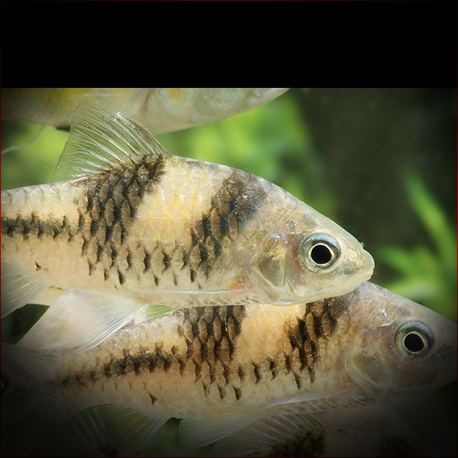More info
Datasheet
| Minimum Tank Size | 300 litres / 79.25 US gallons |
| Maximum Size | 15.0cm / 5.91inches |
| Temperature | 20°C / 68.00°F - 28°C / 82.40°F |
| Hardness | 1.01dgH / 18ppm - 10.03dgH / 179ppm |
| pH | 6.0-8.0 |
General Description
Barbodes Lateristriga, commonly known as the Spanner Barb, is a species of fish closely related to B. kuchingensis. It exhibits a variable color pattern, with lateral markings usually forming a solid stripe. The species was formerly classified under the genus Puntius but was moved to the genus Barbodes due to taxonomic revisions. It can reach a maximum size of 15.0cm and is found in forest streams, pools at the base of waterfalls, and ancient peat swamps in regions such as southern Thailand, Peninsular Malaysia, Sumatra, and Java.
Aquarium Setup
To create an ideal environment for the Spanner Barb, a well-maintained tank resembling a flowing stream with water-worn rocks, sand, and driftwood is recommended. Hardy plants like Microsorum or Anubias can be introduced, ensuring cleanliness due to the species' intolerance to organic pollutants. Good water quality, moderate water movement, and regular water changes are vital for their well-being (see table for specific water conditions).
Behaviour
Known for its boisterous nature, the Spanner Barb can intimidate smaller species, particularly during feeding. In a spacious aquarium, it can coexist with robust fish such as Danios, Barilius, and certain loaches. While juveniles form large groups, mature males tend to become solitary, displaying belligerence in confined spaces. Keeping a group of 6 or more specimens can help diffuse aggression as they establish a hierarchical order.
Feeding and Diet
In the wild, Spanner Barbs are foragers consuming diatoms, small insects, worms, and zooplankton. In captivity, they readily accept live and frozen foods like bloodworms and Daphnia, alongside high-quality dried flakes with plant content. Regular feeding with a variety of foods is essential to maintain their condition and vibrant colors.
Reproduction & Dimorphism
During reproduction, Spanner Barbs are egg-scattering free spawners without parental care. Controlled breeding setups with dim lighting, mesh or plants for egg protection, and specific water conditions enhance breeding success. Adult males exhibit intense coloration, tubercules on the head, and sometimes an enlarged head profile, while females grow larger and are less colorful.
Habitat and Distribution
The Spanner Barb predominantly inhabits forest streams with clear water, varying substrates, and aquatic plants like Cryptocoryne. They are distributed across southern Thailand, Peninsular Malaysia, Sumatra, Java, and other minor islands in the South China Sea. Local variants may exhibit slight differences in appearance based on their habitat.

